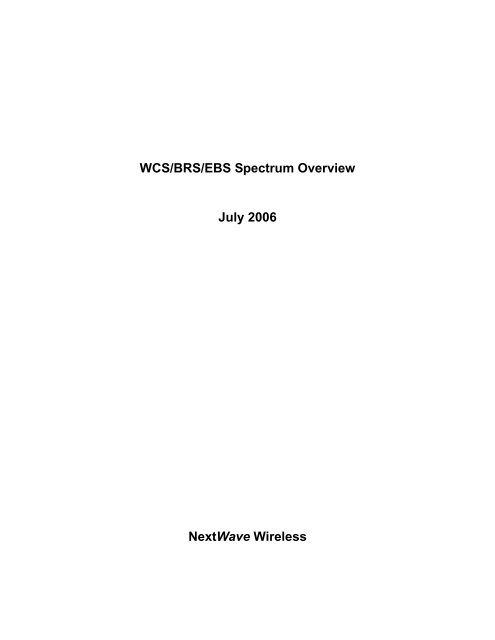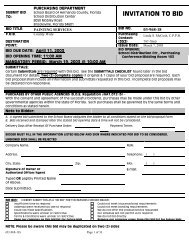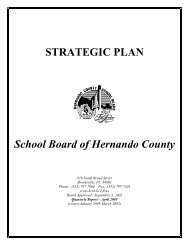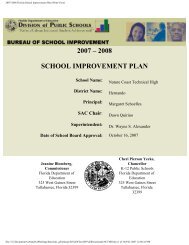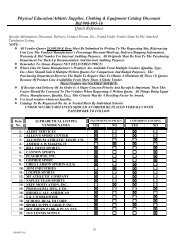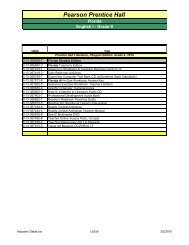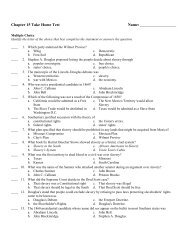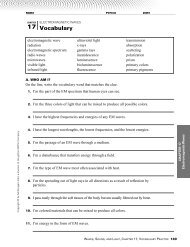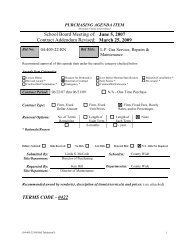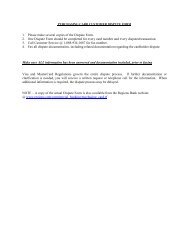WCS/BRS/EBS Spectrum Overview July 2006 NextWave Wireless
WCS/BRS/EBS Spectrum Overview July 2006 NextWave Wireless
WCS/BRS/EBS Spectrum Overview July 2006 NextWave Wireless
You also want an ePaper? Increase the reach of your titles
YUMPU automatically turns print PDFs into web optimized ePapers that Google loves.
<strong>WCS</strong>/<strong>BRS</strong>/<strong>EBS</strong> <strong>Spectrum</strong> <strong>Overview</strong><br />
<strong>July</strong> <strong>2006</strong><br />
<strong>NextWave</strong> <strong>Wireless</strong>
1.0 <strong>WCS</strong> <strong>Spectrum</strong><br />
<strong>Wireless</strong> Communications Service (<strong>WCS</strong>) spectrum may be utilized to deliver advanced, two-way fixed<br />
and/or mobile data, voice and video communication services.<br />
1.1 <strong>WCS</strong> <strong>Spectrum</strong> Allocation<br />
Licenses<br />
128 licenses.<br />
2 licenses in each of 52 Major Economic Areas (MEAs) (See<br />
http://wireless.fcc.gov/auctions/data/maps/mea.pdf for MEA map)<br />
2 licenses in each of 12 Regional Economic Area Groupings (REAGs)<br />
(See http://wireless.fcc.gov/auctions/data/maps/reag.pdf for REAG map)<br />
<strong>Spectrum</strong><br />
30 MHz divided into four blocks<br />
Block A: 2305-2310 MHz paired with 2350-2355 MHz<br />
Block B: 2310-2315 MHz paired with 2355-2360 MHz<br />
Block C: 2315-2320 MHz<br />
Block D: 2345-2350 MHz<br />
Bandwidth<br />
Block A & B - 10.0 MHz ea. in 52 MEAs<br />
Block C & D - 5.0 MHz ea. in 12 REAGs<br />
Table 1 – <strong>WCS</strong> Band Plan<br />
2.2 Permissible Use<br />
<strong>WCS</strong> spectrum may be used for any fixed, mobile (except aeronautical mobile), radiolocation or<br />
broadcast-satellite use consistent with the international agreements concerning spectrum allocations, and<br />
subject to the technical rules of Part 27, Title 47 of the Code of Federal Regulations.<br />
<strong>WCS</strong>-<strong>BRS</strong>-Ovierview-0607.doc Page 2 of 6
2.3 License Period and Construction Requirements<br />
<strong>WCS</strong> licenses are granted for ten-year license terms, and licensees are required to demonstrate that they<br />
are providing “substantial service” in their license area within the initial ten-year license term. Substantial<br />
service is defined as “service which is sound, favorable, and substantially above a level of mediocre<br />
service which just might minimally warrant renewal.” For virtually all <strong>WCS</strong> licensees, the renewal<br />
deadline and the substantial service build-out deadline is <strong>July</strong> 21, 2007. Failure to make the substantial<br />
service demonstration, without seeking and obtaining an extension from the FCC, would result in license<br />
forfeiture. On March 22, <strong>2006</strong>, the <strong>WCS</strong> Coalition, on behalf of almost all of the 2.3 GHz <strong>WCS</strong> licensees,<br />
including <strong>NextWave</strong> <strong>Wireless</strong>, filed a Consolidated Request for Limited Extension of Deadline for<br />
Establishing <strong>WCS</strong> Compliance with Section 27.14 Substantial Service Requirement. This request seeks<br />
to extend the current substantial service deadline by three years from the current deadline (of <strong>July</strong> 21,<br />
2007) or the finalization of formal rules governing the operation of satellite Digital Audio Radio Service<br />
repeaters, whichever occurs later. The request is currently under consideration by the FCC.<br />
2.0 <strong>BRS</strong>/<strong>EBS</strong> <strong>Spectrum</strong><br />
The Broadband Radio Service (<strong>BRS</strong>), formerly known as the Multipoint Distribution Service, and the<br />
Educational Broadband Service (<strong>EBS</strong>), formerly known as the Instructional Television Fixed Service, are<br />
located in the 2.5 GHz band. As depicted in Table 2 below, these services were originally licensed as<br />
interleaved, 6 MHz channels, which were used primarily to provide high-site, high-power, one-way video<br />
operations. Over time, however, these uses evolved to include fixed and mobile, digital, two-way systems<br />
capable of providing high-speed, high-capacity broadband service, including two-way Internet access<br />
service, via low-power, cellularized communications systems or high power single-cell systems.<br />
Optimization of these evolving uses, however, was inhibited by the band plan and service rules that<br />
governed the <strong>BRS</strong>/<strong>EBS</strong> spectrum until 2004.<br />
Until 1996, <strong>BRS</strong> spectrum was licensed according to Geographic Service Areas with a 35-mile radius.<br />
These “incumbent” licenses continue to exist today. In 1996, the FCC conducted an auction and sold<br />
licenses for available <strong>BRS</strong> spectrum according to Basic Trading Areas (BTA) of various sizes (there are<br />
493 BTAs). These BTA licenses were granted subject to the prior rights of the incumbent <strong>BRS</strong> license<br />
holders. <strong>EBS</strong> spectrum is licensed only as Geographic Service Areas with a 35-mile radius, although in<br />
the future, vacant <strong>EBS</strong> spectrum may be auctioned and licensed as BTAs. <strong>EBS</strong> spectrum is licensed<br />
exclusively to accredited educational institutions, governmental organizations engaged in the formal<br />
education of enrolled students (e.g., school districts), and nonprofit organizations whose purposes are<br />
educational. The FCC rules and policies, however, have long permitted <strong>EBS</strong> licensees to lease up to<br />
95% of their <strong>EBS</strong> spectrum to non-<strong>EBS</strong> entities for commercial purposes, subject to compliance with<br />
certain requirements.<br />
<strong>WCS</strong>-<strong>BRS</strong>-Ovierview-0607.doc Page 3 of 6
2.1 New <strong>BRS</strong>/<strong>EBS</strong> <strong>Spectrum</strong> Band Plan<br />
In 2004 the FCC adopted new, flexible <strong>BRS</strong>/<strong>EBS</strong> service rules to facilitate the growth of new and<br />
innovative wireless technologies and services, including fixed and mobile wireless broadband services.<br />
In addition, the FCC reconfigured the 2.5 GHz band plan to combine previously interleaved <strong>BRS</strong>/<strong>EBS</strong><br />
channels, and create upper- and lower-band segments for low-power uses, and a mid-band segment for<br />
high-power operations. By creating contiguous channel blocks, and grouping high- and low-power users<br />
into separate portions of the band, the new band plan reduces the likelihood of interference caused by<br />
incompatible uses and creates incentives for the development of innovative services, which were inhibited<br />
by the prior band plan.<br />
The new <strong>BRS</strong>/<strong>EBS</strong> band plan will allow licensees to use the 2496-2690 MHz spectrum in a more<br />
economically efficient manner and will support the introduction of next-generation wireless technologies.<br />
Under the new regulations, after giving effect to the transition of the spectrum to the new band plan<br />
(which should occur in the next 4 years), the total spectrum bandwidth licensed by the FCC for <strong>EBS</strong> and<br />
<strong>BRS</strong> spectrum is 194 MHz. Approximately 75% of this spectrum is licensed for the Educational<br />
Broadband Service and 25% is licensed for the Broadband Radio Service. Individual channels and<br />
channel groups of <strong>EBS</strong> and <strong>BRS</strong> spectrum will range from 5.5 MHz to 23.5 MHz of spectrum. The new<br />
rules also preserve the operations of existing licensees, including educational institutions currently<br />
offering instructional television programming, and continue the FCC’s long-standing policy of allowing up<br />
to 95% of <strong>EBS</strong> spectrum to be leased for commercial purposes. Licensees must transition to the new<br />
band plan by October 19, 2010 (barring certain disputes in the transition planning process), which<br />
includes relocating licensees from their current channel assignments to new spectrum designations in the<br />
band.<br />
Table 2 – RBS-<strong>EBS</strong> Band Plan<br />
<strong>WCS</strong>-<strong>BRS</strong>-Ovierview-0607.doc Page 4 of 6
2.2 <strong>BRS</strong>/<strong>EBS</strong> <strong>Spectrum</strong> Transition<br />
The transition period has three phases: (1) the Initiation Planning Period, which runs for 30 months from<br />
<strong>July</strong> 19, <strong>2006</strong>, during which an Initiation Plan must be filed with the FCC; (2) the Transition Planning<br />
Phase, which is a ninety-day period that commences upon the filing of the Initiation Plan; and (3) the<br />
Transition Completion Phase, which commences after the Transition Planning Period ends, and provides<br />
eighteen (18) months within which the transition must be completed to complete the physical transition to<br />
the new band plan. Accordingly, assuming no disputes among affected licensees concerning a given<br />
transition plan, the transition period for any given market could last 51 months. Thus, for example, if the<br />
amended rules become effective on <strong>July</strong> 19, <strong>2006</strong>, the transition period for any given market (barring<br />
disputes) could last until October 19, 2010 (see Table 3).<br />
Until a market is transitioned, licensees may continue to operate in accordance with their currently<br />
licensed operations.<br />
Table 3 – <strong>BRS</strong>/<strong>EBS</strong> Transition Timeline<br />
<strong>BRS</strong>/<strong>EBS</strong> Transition Timeline<br />
[<strong>July</strong> 19, <strong>2006</strong>-------------------- ---------------------------------------Jan. 19, 2009]<br />
|___________________|_________________|_____________________|<br />
Effective Pre-transition Transition Initiation<br />
Date of rule data request(s) Notices Plan Filed<br />
Amendments<br />
[---------------------------------------------- 90 days--------------------------------------]<br />
[------------- 60 days----][----------------20 days-------][------10 days------------]<br />
|___________________|______________________|________________|<br />
Transition Transition Counteroffers Transition<br />
Planning Plan Planning<br />
Period Begins Sent Period<br />
Ends<br />
[------------------------------------18 months ------------------------------------------]<br />
|________________________________________________________|<br />
Transition<br />
Transition<br />
Planning Period ends<br />
Completed<br />
<strong>WCS</strong>-<strong>BRS</strong>-Ovierview-0607.doc Page 5 of 6
3.0 More Information<br />
To learn more about <strong>WCS</strong>, <strong>BRS</strong> and <strong>EBS</strong> spectrum, visit these useful sites:<br />
Federal Communications Commission - www.fcc.gov<br />
National ITFS Association (NIA) - www.itfs.org<br />
***<br />
<strong>WCS</strong>-<strong>BRS</strong>-Ovierview-0607.doc Page 6 of 6


